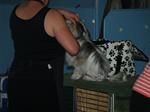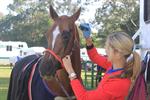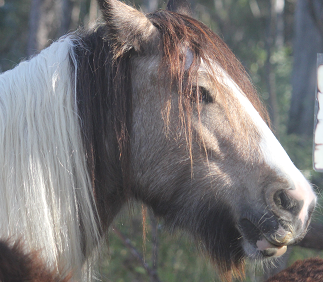COURSE STRUCTURE AND CONTENT
 There are 10 lessons in this course:
There are 10 lessons in this course:
-
Scope and Nature of Grooming
- Introduction to grooming behaviour.
- Why do humans groom animals?
- What animals are groomed?
- Generic grooming tasks.
- Common tools and equipment.
- Combs, brushes, rakes, blades and other equipment.
- Confidently handling animals Introduction.
- The industry and workplace opportunities.
- Workplace skills.
- Accessing the right information online.
- Animal Biology
- Skin – Epidermis & Dermis.
- Claws, Nails and Spurs.
- Hair.
- Horns.
- Hooves.
- Physiological control – Homeostasis.
- Thermoregulation.
- Caring for the Skin and Coat

- Animal nutrition.
- General nutrition.
- Micronutrition.
- Water requirements.
- Common skin problems in dogs and cats.
- Ringworm – fungal infection.
- Flea and flea control.
- Ticks and tick control.
- Lice and control.
- Mites (mange) and control.
- Treating skins problems in dogs and cats.
- Common skin problems in equines.
- Caring for the coat – brushing, bathing, blowdrying, dematting, clipping, trimming.
- Removing burrs from fur.
- Caring for cats – combing, brushing and bathing.
- Specialised Grooming Tasks
- Risks of working with animals.
- Selecting a suitable grooming location.
- Understanding animal psychology and behaviour.
- The flight or fight response.
- Environmental Influence on behaviour in zoo animals.
- General considerations when handling animals.
- Pre-restraint techniques.
- Physical restraint.
- Medical restraint – sedation.
- Safely handling different animals when grooming: dogs, cats, cattle, poultry, rabbits, captive wildlife.
- Handling Horses: Safe and Respectful.
- Catching, releasing, leading, tying up and working around the horse.
- Indicators of pain, mild fear and extreme fear.
- Transporting horses.
- Handling Animals
- Risks of working with animals..
- Selecting a suitable grooming location.
- Understanding animal psychology and behaviour.
- The flight or fight response.
- Environmental Influence on behaviour in zoo animals.
- General considerations when handling animals.
- Pre-restraint techniques.
- Physical restraint.
- Medical restraint – sedation.
- Safely handling different animals when grooming: dogs, cats, cattle, poultry, rabbits, captive wildlife.
- Handling Horses: Safe and Respectful.
- Catching, releasing, leading, tying up and working around the horse.
- Indicators of pain, mild fear and extreme fear.
- Transporting horses.
- Grooming Dogs
- Communication in dogs.
- Use of scent.
- Barking & body language.
- Grooming different types of dogs.
- Long Coat types.
- Short coat types.
- Single coat types.
- Double coat types.
- Smooth coat types.
- Wire haired coat types.
- Woolly or wavy coat types.
- Corded coat types.
- Bald or hairless coat types.
- Brushing and bathing care.
- Clipping and styling.
- Grooming procedures that can go wrong.
- Cutting toenails too short.
- Cuts or nicks when clipping.
- Overheating.
- Water trapped in the ear canal.
- Grooming Exotic Animals
- Grooming birds.
- Handling birds.
- Beaks.
- Feathers.
- Bathing birds.
- Grooming rabbits.
- Handling.
- Moulting.
- Transporting.
- Grooming captive wildlife.
- Bathing small and large mammals.
- Handling large animals and exotics.
- Dangerous animals.
- Fear of humans.
- Issues with handling animals.
- Psychological effects of different handling techniques.
- Grooming areas.
- Safety in a Grooming Workplace
- Safety for people and staff – workplace health and safety.
- First aid.
- Legislation and duty of care.
- Safety of animal owners and visitors to the premises.
- Protective equipment.
- A groomer’s personal protection.
- Equipment and workplace safety.
- Storage and disposal of chemicals.
- Handling Tools and Machinery.
- Safety with tools and equipment.
- Safety audit.
- Example of an audit checklist.
- Safety for animals and people.
- Transportation.
- Safety of the animal at the salon.
- Electrical safety – at home and the groomers.
- Slip risk – wet surfaces.
- Cat and dog allergies.
-
 Preparing for Showing
Preparing for Showing
- What is animal showing?
- Why do people show pets?
- Showing dogs.
- Training your show puppy.
- Preparing for show – dogs.
- Days and evening before the show.
- The day of the show and in the ring.
- Showing – dress to impress.
- Showing poultry.
- Getting started – selecting your breed and buying your birds.
- Preparing birds for show.
- The day before the show.
- The day of the show.
- Showing cattle.
- Preparing cattle for show.
- In the show ring on the day.
- The Business of Grooming Planning a new grooming business
- The business plan.
- Financial planning.
- Long term goals.
- Medium term goals.
- Annual financial plan.
- Financial records.
- Commonly used finance related terminology.
- Cash flow.
- Make the business a success – know your market.
- Insurance and risks – risk analysis and managing risk.
- Groomers insurance.
Each lesson culminates in an assignment which is submitted to the school, marked by the school's tutors and returned to you with any relevant suggestions, comments, and if necessary, extra reading.
COURSE AIMS
- Discuss the scope and nature of grooming animals, including the animals that are commonly groomed, the situations in which they are groomed, equipment that is used and the tasks carried out by a groomer.
- Describe external anatomical structures and physiological processes of animals which are relevant to grooming.
- Describe how to manage the coats of different types of animals.
- Discuss tasks used in grooming animals that are supplementary to grooming the coat.
- Describe a range of techniques used to control a variety of different types of animals during grooming.
- Compare grooming techniques used for different types of dogs.
- Describe a range of techniques used to groom a variety of different types of animals other than dogs.
- Determine protocols for safety of both animals and groomers, when grooming different types of animals
- Explain how to groom dogs, cats, horses and a variety of other animals for a show.
- Explain how to establish or improve a grooming business to be more successful.
What You Will Do
-
Access the internet and find an organisation which cares for animals other than companion animals. Investigate the role of animal groomers in caring for the animals in their facility.
- Go to a local pet shop, feed store, livestock equipment stockist or wholesaler and view the range of grooming equipment for sale. You should take photographs of any equipment you view.
- Watch a number dogs being clipped – coat trimming. You may watch these in person at a grooming facility or you may opt to watch these online if attending a grooming salon is not possible. You should make notes on how the dogs are handled, communicated with and treated by the professional groomer.
- Attend a show and observe animals being groomed, ahead of judging. If you cannot attend a show in person, search the internet and watch videos of animals being groomed for competition at shows.
- You should go through the process of bathing an animal you have access to. After bathing you are expected to dry the animal in an appropriate way for that particular animal. Once dried you should undertake further grooming actions suitable for the animal e.g. ear cleaning, cleaning out the hooves, sponge cleaning the eyes etc. (whatever is relevant to the animal).

More to Hair Care Needed
than What You Might Think!
A cross section of a hair reveals two or three layers. The ‘core’ of the hair is called the cortex. This contains the pigment of the hair. The outside layer is called the cuticle. This layer is a set of microscopic overlapping scales. The size, shape and pattern of these scales differ between species and breeds to the point where an individual hairs may be identified by the cuticle pattern. Some hairs may also have a medulla, which may be described as an area of dead cells and air spaces.
All mammals have hair on their skin to some degree and it is a distinct mammalian feature. This includes marine mammals which at times appear to be hairless.  Hair has attachments to nerves and muscles. The tiny smooth muscles which are attached to the hair make the hair stand up when contracted. This accounts for goose-pimples in humans. It is also the mechanism for our hair standing on end and animals puffing up their coats when cold. Contraction of these papillary muscles and the subsequent increase in the density of the coat creates an insulation effect and assists to conserve heat in furred animals.
Hair has attachments to nerves and muscles. The tiny smooth muscles which are attached to the hair make the hair stand up when contracted. This accounts for goose-pimples in humans. It is also the mechanism for our hair standing on end and animals puffing up their coats when cold. Contraction of these papillary muscles and the subsequent increase in the density of the coat creates an insulation effect and assists to conserve heat in furred animals.
Fur is dense hair. It augments the insulation qualities of the skin but can also act in other roles, such as secondary sexual characteristics or as a camouflage tactic. Hair obviously has big advantages; but it can also create problems for the animal's health, apart from any consideration of appearance.
Groomers need to understand the biology of the animals they groom. Hair, claws, skin, horns and hooves, all have a structure and a purpose; and grooming is not just about removing hair and other growths. These things should be removed, cleaned or treated in other ways, using the appropriate techniques, and for a valid reason.
Grooming is Booming!
With more pet ownership than ever before, there has never been a better time to get into the animal grooming industry. Whether you wish to start your own business or gain employment as a groomer, this course is a great first step along that path.
This course is perfect for you as it:
- introduces grooming techniques for cats, dogs, small and large animals
- covers the use of common grooming equipment and tools
- teaches anatomy, skin and coat health
- advise how to start a business as a groomer, follow easy practical business tips
- expands your confidence to work in the animal showing industry –either for work or as a hobby
All you require is a passion for animals and we’ll supply you with the knowledge and skills to get your new animal grooming business started!
WHAT NEXT?
Register to Study - Go to “It’s Easy to Enrol” box at the top of the page and you can enrol now.
or
Get Advice – Email us at info@acsedu.co.uk OR
Use our FREE COUNSELLING SERVICE to contact a tutor
CLICK TO CONTACT US